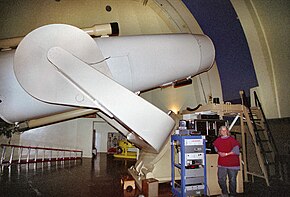 | |
| Alternative names | Oschin Schmidt |
|---|---|
| Named after | Samuel Oschin |
| Part of | Palomar Observatory |
| Location(s) | San Diego County, California, Pacific States Region |
| Coordinates | 33°21′29″N 116°51′43″W / 33.358194°N 116.861806°W |
| Built | 1939–1948 |
| Telescope style | optical telescope Schmidt camera |
| Diameter | 48 in (1.2 m) |
| | |
The Samuel Oschin telescope (/ˈɔːʃɪn/), also called the Oschin Schmidt, is a 48-inch-aperture (1.22 m) Schmidt camera at the Palomar Observatory in northern San Diego County, California, United States. It consists of a 49.75 inches (1.264 m) Schmidt corrector plate and a 72 inches (1.8 m) (f/2.5) mirror. The instrument is strictly a camera; there is no provision for an eyepiece to look through it. It originally used 10 inches (25 cm) and 14 inches (36 cm) glass photographic plates. Since the focal plane is curved, these plates had to be preformed in a special jig before being loaded into the camera.
Construction on the Schmidt telescope began in 1939 and it was completed in 1948. It was named the Samuel Oschin telescope in 1986. Before that it was just called the 48 inches (1.2 m) Schmidt.[1]
In the mid-1980s, the corrector plate was replaced using glass with less chromatic aberration, producing higher quality images over a broader spectrum.[2]
Between 2000 and 2001, it was converted to use a CCD imager. The corrector plate was recently replaced using glass that is transparent to a wider range of wavelengths.[when?] The telescope was originally hand-guided through one of two 10-inch-aperture (0.25 m) refracting telescopes mounted on either side. The camera is now fully automated and remote-controlled. The data collected are transmitted over the High Performance Wireless Research and Education Network (HPWREN). It is programmed and operated primarily from Pasadena, California, with no operator on site, except to open and close the observatory dome.
- ^ "Discoveries from Palomar Observatory's 48-inch Samuel Oschin Telescope". Archived from the original on 2011-06-24. Retrieved 2011-06-27.
- ^ Butowsky, Harry (May 1989). "Palomar 48-inch Oschin (Schmidt) Telescope". Astronomy and Astrophysics. National Park Service.
A new 48-inch-diameter corrector plate was made by Grubb-Parsons in England and installed in the telescope. This new plate produces better images over a wider range of wavelengths than the original.
